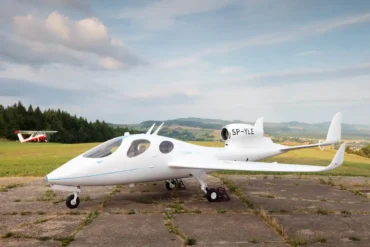Exploring the evolution of Very Light Jets (VLJs) since the Morane-Saulnier MS 760 Paris jet’s debut in the 1950s reveals a 50-year journey towards maturity. Unnamed back then, the VLJ category saw early entrants from Cessna, notably the 407, a four-seat adaptation of the T-37 jet trainer, and the single-pilot Fanjet 500, both abandoned during the design phases. The ’70s and ’80s witnessed attempts like the Gulfstream FanJet 1500 and CMC Leopard, yet they failed to carve a profound niche in private aviation.
In the early 2000s, a trio of game-changers—Embraer Phenom 100, Cessna Citation Mustang, and Eclipse 500—ushered in a new era known as Very Light Jets (VLJs), alternatively dubbed “Personal Jets” or “Micro Jets.” The Citation Mustang, the smallest in the Citation line, emerged as the face of the category from its 2006 launch until its production ceased in 2017, boasting record-breaking sales. Eclipse had an impressive begin in 2006, but the Great Recession posed challenges. However, the Cirrus Vision SF50 and its successor, the G2+ Vision Jet, stole the spotlight post-2018, recently surpassing Citation Mustang sales.
Unlike their midsize and ultra-long-range counterparts, VLJs often feature unique designs, varying cabin configurations, and one or two engines. Despite individuality, they share characteristics. Typically weighing under 10,000 pounds, these jets accommodate a single pilot (some models allow for dual cockpit configuration). Most boast cockpit automation with features like moving map GPS, multi-function displays, automated engine and systems management, and integrated autoflight, autopilot, and flight-guidance systems. Some even include advanced safety features like Garmin’s AutoLand, stepping in if the pilot is unable to operate, and the Cirrus Jet features a deployable CAPS parachute system.
Here are seven of our preferred picks.
Cessna Citation Mustang

Introduced in 2006, Cessna’s inaugural Very Light Jet, the Citation Mustang, soared with over 500 units in the air by the end of its creation in 2017. With a single pilot, G1000 avionics suite, and powered by two Pratt & Whitney PW615F turbofans, it accommodates four passengers and two pilots (or a passenger) in the cockpit. Offering 963 nautical miles in range and 340 knots of true airspeed, it’s a reliable option.
Cirrus G2+ Vision Jet

Crafted for style, comfort, and safety, the revamped Cirrus G2+ Vision Jet has excelled since the SF50’s inception in 2016. The carbon-fiber fuselage creates a spacious cabin for up to six passengers, complemented by panoramic windows for an enhanced travel experience. The pressurized cabin, designed for work and entertainment, incorporates advanced safety features, including the Cirrus Airframe Parachute System. In emergencies, the Vision Jet transforms into an autonomous vehicle with the Safe Return Emergency Autoland function, developed with Garmin. With a range of 1,275 nautical miles, true airspeed of 305 knots, 1,350-pound payload, and takeoff distance of 2,036 feet, it’s an impressive choice.
HondaJet HA-420

Announced in 2005 and FAA-certified a decade later, the HondaJet showcases innovation with over-the-wing engine mounts for enhanced fuel efficiency and decreased noise. Touchscreen controls, developed with Garmin, contribute to the single-pilot aircraft’s appeal. With a capacity for seven occupants, it boasts a range of 1,223 nautical miles and 422 knots of true airspeed, with a takeoff length of 3,934 feet.
HondaJet Elite II

Launched in October 2022, the HondaJet Elite II enhances range, fuel capacity, gross weight, and safety features. With a range expanded to 1,547 nautical miles and a decreased takeoff distance of 3,699 feet, it offers Garmin’s Autoland as an option. Design improvements include in-cabin, speaker-less audio, acoustic enhancements for lowered external noise, swiveling leather seats, and skylights in the lavatory.
Eclipse 550

Sporting a six-seat interior designed for business and pleasure, the Eclipse 550 stands out as a twin-engine, single-pilot jet with remarkable fuel efficiency. Consuming 59 gallons per hour, it cruises at 41,000 feet with a max speed of 431 mph. Despite ownership changes, its efficiency remains unmatched.
Embraer Phenom 100EX

Unveiled in October, Embraer’s Phenom 100EX, a six-passenger marvel, blends operational versatility with advanced avionics and safety features. With a Garmin Prodigy Touch flight deck, emergency descent mode, predictive windshear, and more, it offers a range of 1,178 nautical miles, a max cruising speed of 406 knots, and generous baggage storage.
Citation M2 Gen2

Positioned as a successor to the popular Mustang, Cessna’s Citation M2 Gen2 straddles the line between VLJ and larger light jets. With two William FJ44 engines, Garmin’s touchscreen G3000 avionics, autothrottle, and a potential range of 1,550 nautical miles, it offers a compelling option for travel, entertainment, or work with an eight-person capacity and a takeoff distance of 3,210 feet.


















